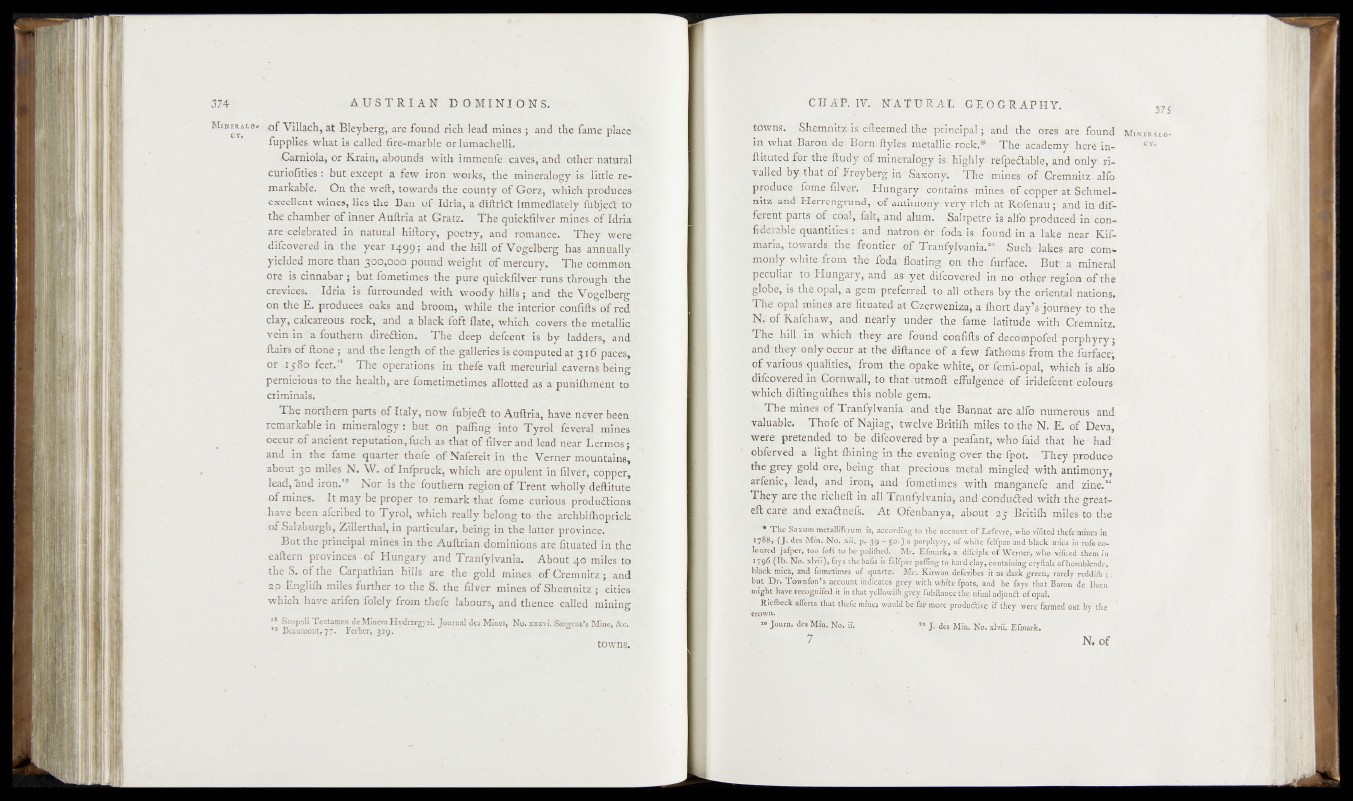
3 7 4 A U S T R IA N D O M IN I O N S.
^ Villach, at Bleyherg, -are found rich lead minés ; and "the lame.place1
fupplies what is called.fire-marble ordusmachelli.'-* $
.Camiola, or-Krain, abounds with immenfe-'cav'es, and. (Other natural
curiofities : but except a 'few iïöto works, the minefafog^lte'lktlè 'rè>
markable. On the weft, towards the cotïnty of Gorz, whidh ‘ij&d'iaèé®
excellent wines, Kesfhe Ban o f Idria, a diftridt immediately fuBjédBto
the.chamber of inner Auftria at Gratz. The quiêfefrlver minés o f Itfeia
are .celebrated in natural hiftoryj poetry, and romance. They were
difcovered in the year 1499; and the hill o f Vogelberg has annually.
“ yielded more than 300^000 pound weight óf mercury." _The common
.ore i s cinnabar; but fometimes the pure quickfilver runs through* the
crevices.. Idria is furrounded with woody hills'; and the ^ g elb erg
on.the E. produces oaks andjmbtn,< while thè 'interiör confift^tff réd
clay,- calcareous -rock, and a black loft-flate,'which covers the metallic
vein in a foutherh direction. The - deep defcent is by’- ladders^ and
Hairs of ftohe; and the length o f the galleries is computed at 3 r6; paces,
or ,i j 8o feet.- The. operations iir thele vaft mercurial'caverns being
pernicious -to -the health, are fometimetimes allotted" asf a-puhiihmerit tdf
criminals.
The northern parts of Italy, now fubjeft to Auftria, have never licfeii
remarkable in mineralogy: but on* paffing into Tyrol feveral m£nc§|
occur o f ancient reputation-, fuch as that of filver and lead near licgnlos^
and in the fame quarter thofe o f Nafereit in the Verner mountains,
about 30 miles N. W. o f Inlpruck, which are opulent irrfihrer, ‘cqppeT,
lead,'and iron.*9 Nor is the fouthern region 'óf Tfent'wholly deftituté:
■of mines. It may be proper to remark that fome curious productions
.have been aferibed to Tyrol, which really belong to the archbiftioprick
-°-f..Salzburgh, Zillerthal, in particular, being in the latter province.
-But the .principal mines in the Auftrian dominions arerfitüated in the
eaftern provinces o f Hungary and Tranlylvania. About 4 0 miles to
the S. of the Carpathian hills are the gold mines o f CremnitZ; and
2p Englifti.miles further to the S. the filvér mines o f Shemnitz,;. cities
which have arifen folely from thefe labours, and thence called mining
. 18 Scopoli Tentamen de Minera Hydrargyri, Journal dej Mines, No. xxxvi. Sflrgcnt’e Mine,&c.
19 Beaumont, 77. Ferber, 329*
towns.
CHAP. IV.' F A T U K A B G'E'OG&APBY. 3-75
-itbwns. _ principal-; 'anft$he ores are found
'$n v^at;Ba>romd(r’Bbrftl ftyleb academy, here in-
• f t i t ut e dv . f o imiMt e Sa l 0 g y »f&j:;]£4gfeiy4%c|p'e.£tiable, and only ri-
I The Gremiiitz. alfo
produce -.Cdme Schmeln
i t z L i 'a n d ^ % ^ n g ^ i |h a ^ i « ^ i ^ ^ f e ^ ^ l | | l i ^ t ‘JR k e h iu | !'ind. i b diffe
ren t parts >'q^|g|a|^|^.lt||^:nd* ahum. S d lH ^ f^ ^ ^ lf^ ftfo id u d e d 1 in 'co n -
fiderable quantities?:.'* and* Hatvo*!f.*bfe'feis f o l l i ^ i h ^ - ^ k e n e a r Kif-
mafia,- to i^ -rd ^ fthe fronrien'. d f .Tn&^ljfanlfc.“. S u ch lak e s are eoim
m o b ty w M j f i o m f ^ |© d ^ J 4 't n ^ b ^ thsi-futface.: • B u « a mineral
peculiar. other region o f the
g lq b e ;|i# h e ^o p 4lii^ tn v p ie f e .r a e d tp aW> o® ,rs ‘ by/thc'<oriontabnaticJns.
.The dpa^maaies-artefot&ated?^©jferweni^a, a-mferf‘| a y ^ ^ u r h ’d y ifc th e
N j of-R a feh a ^ , .and' nearly iu n d e t th e fampAfetud^t,w®hlCrfemnitz.
Th e-hill i a '(which th e y 'a r e 'found ^oriftft’s5o f d e cQ lB ^ ^ e ^ p y rpS y ry ;
arid, they'.only ©ccu^ at* the diftarice ©f a few theTurface*,
o f;v a rio u s qiuabties=,ii from th e opake white!' crfferrii^epal^' Which, is .alfa
di%Svereddii*Gbrr£wall,. to th a t .'utmoft%Ft%e'nce ofhMdhfceriti c o lo u r^
which diftingulffiest®ds3n!c>hl©-geln. :
^'The.mi-nSsftiF Tranfi^Ivania and ilrije? Bannat are alfbf nUSmerOus; and
valpableti . Thofe of Najiag,: twelve* Britiftv m ifesito^heNlift'of Deva*
werer pretendedl’-tri be. diferivered by^akp^^'antrwhri find- that fife had
©hferved a light, fhiningm the. e y e in g oVekthte fpot. They produce
the grey, gold ore,, being', that precious tnetaf mingled: with* antimony,
arfenic, lead, and iron, and >fometimes with manganefe and- zinc.*1
They are the richeft nj all Tnanfyl-vaniaj and'G^adutfted with the great-
eft »are and exa£tnei&l At dfenfeany*, abcfiit; 25 Britiftx'miles'to the
* T h e Saxum mctalliferum ft; ae'co'rdm',g 'W tl4 ê ‘ actê'iJn^-oPTe:f?Yr£,'who vifited thefe mines in '
ïy S S , (J. des Min. No; Sii. p. 3 9 —50.) a porphyiy, o f white felfpai; and black mica in rofe co-
loured jafper, too foft to be polifhed. Mr. Efmark, a difciple o f Wernei-j.wlip vifited them in
X796 (lb - No . x lv ii), fays the bails is felfpar palling tohard clay, containing cry liais ofhornblendc, *
black mica, and fometimes o f quartz; Mr. IGnvan deferibes it as dark green, rarely reddilh
but Di-. Townfon’ s aefcotml; indicates g rey with white fpots, and he fays that Baron de Boni
might have recognifed it in that yellowifii grey fubftancetlie.ufual adjund o f opal.
Riefbeck afferts that t-Kefe mines would be far more productive i f they were farmed out b y the
crown.. -1
*> Joura. des M ia. No, ii. « J. dès Mia, No. xlvii. F.rm»>ir,
• 7 I
MiNKaAioï!
J. des Min, No, xlvii, Efmark.
N. of